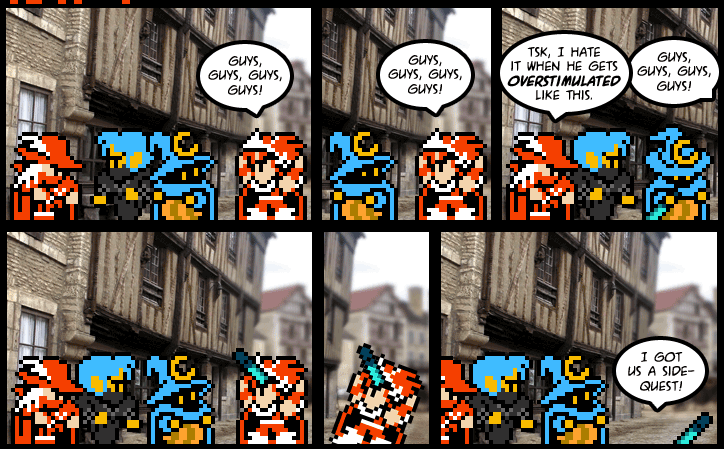If you've ever done a random browse of webcomics over the past decade, chances are you ran into a sprite comic.
The sprite comic uses aesthetics from the early generations of video games, an era spanning the rise of Pac-Man and Donkey Kong to the video game crash of 1983 to the rebirth under Mario and Mega Man once Nintendo came to dominate the market. The aesthetic itself has evolved and flourished in a variety of media. A lot of it is deeply rooted in nostalgia, as when Community aired an episode in which the characters are sprites in an '80s-style RPG.
The style reminds people of a large chunk of their childhood spent wiggling joysticks or pressing buttons in their living rooms. Other times, it's a combination of nostalgia and programming efficiency. For that reason, sprites flourish among indie gaming companies and app games, such as the charmingly retro sims from Kairosoft. And it's cute. Who doesn't want plushies of the various squat, big-eyed avatars of the 8-bit era?
With early webcomics gaining a big fandom among the gamer crowds, combining sprites with webcomics is a completely natural development. Kind of like combining chocolate and peanut butter. Often getting credit for being the first to popularize the sprite comic, Bob and George (2000-2007) told stories within the Mega Man universe. Its creator, Robert Anez, was called "the father of sprite comics" by Brian Clevinger (creator of the Eisner-nominated Atomic Robo), who also had a popular sprite comic: 8-Bit Theater (2001-2010), which followed adventurers on quests in the Final Fantasy universe. Richard Stevens' Diesel Sweeties, which began in 2000, adhered to the aesthetic with original characters... and was, for a short time, one of the few webcomics to make the jump from digital to the newspaper funny pages.
It also produced a lot of garbage. As every character is generally rendered in the same scale and the same sideways or three-quarters position from panel to panel, sprite comics became the favorite style for the laziest webcomic creators. Clevinger could get away with it because he has a knack for writing dialogue that's clever at times, silly at times, but always full of personality. It goes without saying that most creators struggle with that sort of thing. In a 2007 episode of Homestar Runner, the Brothers Chaps take potshots at the entire genre. "If you can't draw, never fear," says Strong Bad. "Just steal some graphics from your favorite video game. And add yet another unlicensed pixel comic to the overcrowded, overstunk landfill of web comics."
After 8-Bit Theater ended in 2010, no other sprite comic really achieve the same amount of popularity. Maybe this is the end of the road for sprite comics, to be abandoned to the low-ranked netherworlds of webcomic collectives?
I'd like to think that there's a lot of untapped potential still. While not a sprite comic, Andrew Hussie successfully integrates the controls and style of a Japanese RPG in MS Paint Adventures: Homestuck. These portions are interactive. Readers use the keyboard keys to walk around and speak with others, who divulge important background information and plot developments. For their trouble, the reader is rewarded by a large, animated, anime-styled portrait of the characters who are typically rendered as super-deformed sprites in the interactive portions and as squat, limbless, oval-headed representations in the rest of the comic.
Here's what I'd like to see, though. While not exactly a sprite per se, various online artists have proved that pixel art can look absolutely gorgeous if enough time is spent on creating it. Artist Mark Ferrari programs in HTML5, and he employs simple palette swaps to create an illusion of animation. It's got a look reminiscent of '90s Sierra adventure games ... perhaps the next step in sprite comics once society is exhausted of '80s nostalgia. Might we see a day when Ferrari's evocative art style is used in service of telling a story?

